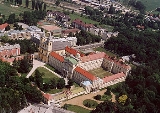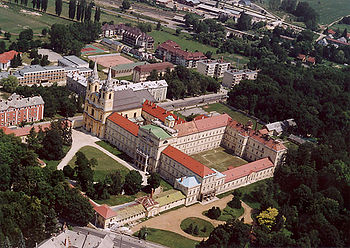
Zirc Abbey
Encyclopedia

Abbey
An abbey is a Catholic monastery or convent, under the authority of an Abbot or an Abbess, who serves as the spiritual father or mother of the community.The term can also refer to an establishment which has long ceased to function as an abbey,...
, situated in Zirc
Zirc
-Attractions:*Zirc Abbey, a Cistercian abbey*Zirc Arboretum*Bakony Museum of Natural Sciences, situated in the territory of Zirc Abbey-External links:*...
in the Diocese of Veszprém, Hungary
Hungary
Hungary , officially the Republic of Hungary , is a landlocked country in Central Europe. It is situated in the Carpathian Basin and is bordered by Slovakia to the north, Ukraine and Romania to the east, Serbia and Croatia to the south, Slovenia to the southwest and Austria to the west. The...
.
First period
The early history of the monastery is obscure as regards both names and dates, on account of its being so often referred to under both these titles: whether Zirc and Boccon were separate abbeys cannot now be definitely determined. It seems most probable that the foundation was made by Béla IIIBéla III of Hungary
Béla III was King of Hungary and Croatia . He was educated in the court of the Byzantine Emperor Manuel I who was planning to ensure his succession in the Byzantine Empire till the birth of his own son...
, King of Hungary (1182), as the monastic domain was formerly a royal farm. Besides this grant, on which now stands the city of Zirc, many other donations were made to the nascent abbey, which soon became one of the most celebrated in the country. It was rich not only in temporal possessions but also in the spirit of fervor and religious regularity. In 1232 the foundation of Kutjevo Abbey
Kutjevo Abbey
Kutjevo Abbey, also known as Gotó was a Cistercian monastery in what is now Croatia, in the area of Slavonia, 23 km north-east of Požega.- History :...
in the present Croatia
Croatia
Croatia , officially the Republic of Croatia , is a unitary democratic parliamentary republic in Europe at the crossroads of the Mitteleuropa, the Balkans, and the Mediterranean. Its capital and largest city is Zagreb. The country is divided into 20 counties and the city of Zagreb. Croatia covers ...
was made from Zirc, which became its mother-house.
This happy state continued for three centuries, but decadence set in before the end of the fifteenth century, and by 1526 the ravages of the Ottoman invasion of Hungary had depopulated the monastery, not one religious remaining at the end of the year. The buildings and possessions passed into the hands of laymen.
Second period
In the seventeenth century (1609) it was acquired by Canon Mihály Monoszlay. Thenceforth it remained the property of ecclesiastics, and in 1659 it was given to Holweis, Abbot of the Cistercian Lilienfeld AbbeyLilienfeld Abbey
Lilienfeld Abbey is a Cistercian monastery in Lilienfeld to the south of Sankt Pölten in Lower Austria.- History :It was founded in 1202 by Leopold VI, Duke of Austria and Styria, as a daughter house of Heiligenkreuz Abbey...
, who appointed Márton Újfalusy (1660) its abbot, thus reviving it. From the jurisdiction of Lilienfeld it was transferred successively to that of Klostermarienberg Abbey (Borsmonostor) (1678) and Heinrichau Abbey (1700). From the latter abbey came a number of religious who gradually restored first the monastic buildings and church (consecrated 1745) and then regular observance in its primitive vigour.
In 1810 the community, in common with many others, was expelled, but was restored in 1814 under Abbot Antonius Dreta, from which time the abbey prospered more than ever before. Under his administration the abbeys at Pilis
Pilis
-History:It was inhabited in the prehistoric times, but later it was abandoned at the end of the Roman rule. The town was then first mentioned in 1326. It was destroyed during the ottoman rule in the 16th century, and was reestablished only in 1711, by János Beleznay, the local landlord. He brought...
and Pásztó
Pásztó
Pásztó is a town in Nógrád county, Hungary.- External links :*...
were united to Zirc, as was likewise, in 1878, the abbey at Szentgotthárd
Szentgotthárd Abbey
Szentgotthárd Abbey is a former Cistercian monastery in Szentgotthárd in Vas County in the south-west of Hungary, about 3 km from the present border with Austria and 18 km from that with Slovenia.- History :...
. In 1923 the Congregation of Zirc was established.
After World War II
World War II
World War II, or the Second World War , was a global conflict lasting from 1939 to 1945, involving most of the world's nations—including all of the great powers—eventually forming two opposing military alliances: the Allies and the Axis...
and the Soviet takeover of Hungary, many of the monks gradually escaped the country. A large number of them went to Wisconsin
Wisconsin
Wisconsin is a U.S. state located in the north-central United States and is part of the Midwest. It is bordered by Minnesota to the west, Iowa to the southwest, Illinois to the south, Lake Michigan to the east, Michigan to the northeast, and Lake Superior to the north. Wisconsin's capital is...
(USA) and served at Spring Bank in Sparta, Wisconsin
Sparta, Wisconsin
Sparta is a city in and the county seat of Monroe County, Wisconsin, United States, along the La Crosse River. The population was 9,522 at the 2010 census.-Notable people:*William Hawley Atwell, U.S. District Court Judge in Texas*Larry Baumel, NASCAR...
, founded by Dutch monks in 1928. By 1956, however, a small group of these Hungarian Cistercians left Wisconsin to found Our Lady of Dallas in Irving
Irving, Texas
Irving is a city located in the U.S. state of Texas within Dallas County. According to the 2010 U.S. Census, the city population was 216,290. Irving is within the Dallas–Plano–Irving metropolitan division of the Dallas–Fort Worth–Arlington metropolitan area, designated...
, Dallas County, Texas
Dallas County, Texas
As of the census of 2000, there were 2,218,899 people, 807,621 households, and 533,837 families residing in the county. The population density was 2,523 people per square mile . There were 854,119 housing units at an average density of 971/sq mi...
.
Zirc Abbey was dissolved in 1950, and its church became a parish church. The monastery was re-established in 1989 and maintains residences in Eger
Eger
Eger is the second largest city in Northern Hungary, the county seat of Heves, east of the Mátra Mountains. Eger is best known for its castle, thermal baths, historic buildings , and red and white wines.- Name :...
, Baja
Baja
-Geography:* Baja California peninsula, a peninsula in North America* States of Mexico** Baja California** Baja California Sur* Baja Arizona* Baja, Hungary* Baja Verapaz, a department of Guatemala...
, Budapest
Budapest
Budapest is the capital of Hungary. As the largest city of Hungary, it is the country's principal political, cultural, commercial, industrial, and transportation centre. In 2011, Budapest had 1,733,685 inhabitants, down from its 1989 peak of 2,113,645 due to suburbanization. The Budapest Commuter...
, Pécs
Pécs
Pécs is the fifth largest city of Hungary, located on the slopes of the Mecsek mountains in the south-west of the country, close to its border with Croatia. It is the administrative and economical centre of Baranya county...
and Székesfehérvár
Székesfehérvár
Székesfehérvár is a city in central Hungary and is the 9th largest in the country. Located around southwest of Budapest. It is inhabited by 101,973 people , with 136,995 in the Székesfehérvár Subregion. The city is the centre of Fejér county and the regional centre of Central Transdanubia...
.

